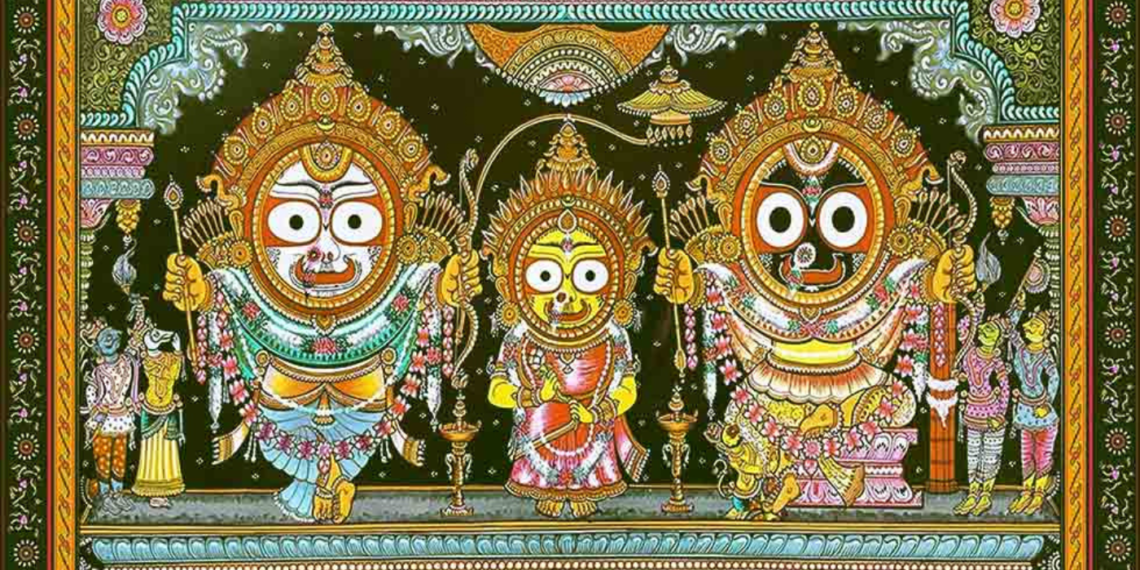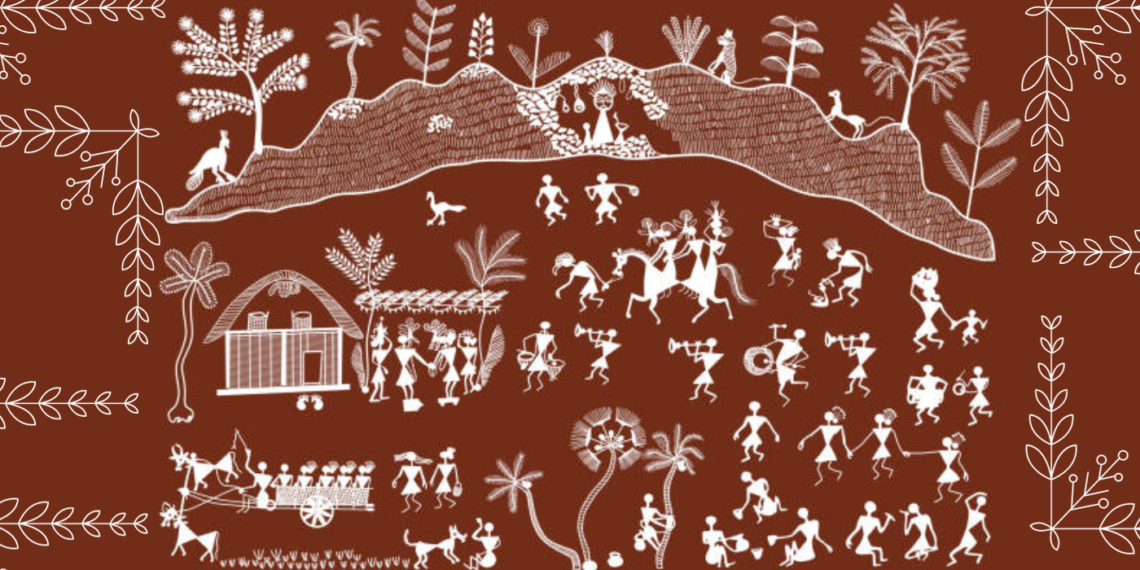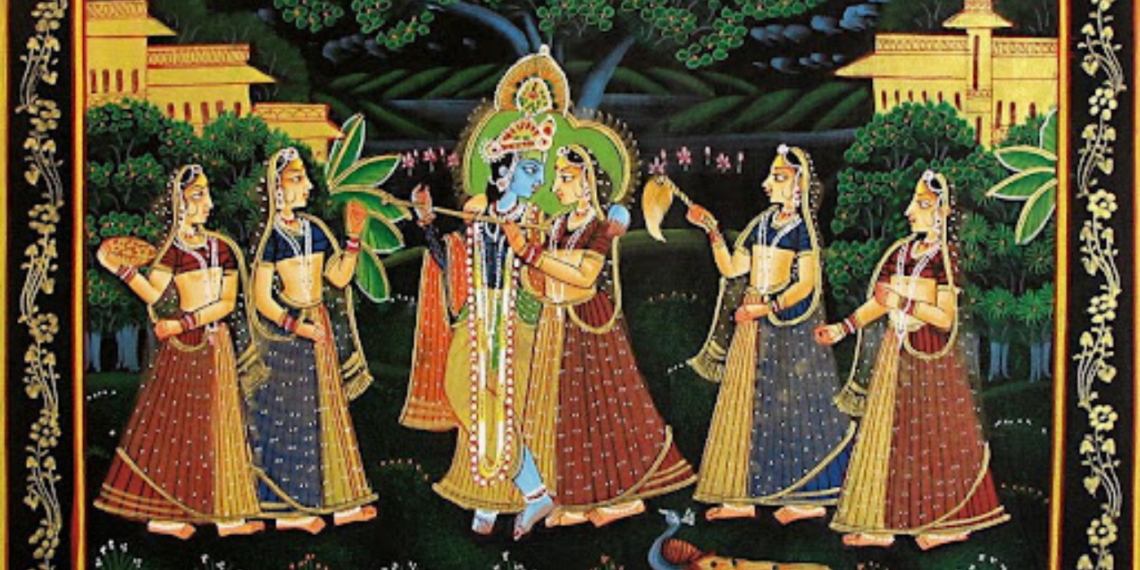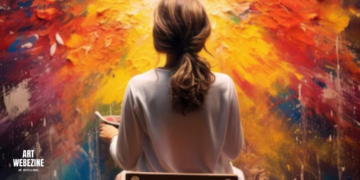India, a land steeped in ancient traditions and rich cultural heritage, is also a vibrant hub of artistic expression. From the intricate carvings of ancient temples to the vibrant hues of contemporary paintings, India’s art forms have captivated the world for centuries. Join us on a journey through India’s artistic artwork as we unveil seven renowned art forms that will leave you in awe of their beauty and craftsmanship.
Famous Indian Art Forms:
Madhubani Art: A Vibrant Expression of Folk Traditions

In the heart of India, amidst the vibrant landscapes of Bihar, lies a captivating art form that has captivated the world with its bold lines, rich colors, and intricate narratives – Madhubani painting. Rooted in the Mithila region, Madhubani art, also known as Mithila painting, is a traditional folk art form that has been passed down through generations of artisans, each adding their unique touch to this artistic legacy.
A Journey Through Madhubani’s Artistic Tapestry
Step into the world of Madhubani art, where mythological tales and scenes from rural life unfold with captivating simplicity and elegance. The paintings are characterized by their distinctive use of natural dyes, typically extracted from plants, flowers, and minerals. The vibrant hues of red, yellow, blue, and green dance across the canvas, creating a visual spectacle that is both mesmerizing and meaningful.
Depicting Mythological Tales and Rural Life
Madhubani paintings are not merely artistic creations; they are visual narratives that transport viewers to a world of gods, goddesses, and folktales. The paintings often depict scenes from Hindu mythology, such as the epics of Ramayana and Mahabharata, bringing these timeless stories to life with vibrant colors and expressive figures.
Alongside mythological narratives, Madhubani art also celebrates the beauty and simplicity of rural life. Scenes of farmers working in their fields, women performing household chores, and children playing joyfully adorn the canvas, capturing the essence of daily life in the Mithila region.
The Artistic Process: A Symphony of Colors and Techniques
Madhubani painting is a time-consuming and meticulous process involving cow dung and mud, a fine brush dipped in natural dye and rice paste, and outlines of figures and motifs.
The main task is to fill the outlines with color, using natural dyes extracted from plants, flowers, and minerals. The artists move their brushes with precision and fluidity, creating a symphony of colors that brings the paintings to life.
A Legacy Preserved: Madhubani Art in the Modern World
Madhubani art, a traditional Indian art form, has evolved over centuries and is now found in galleries, museums, and homes worldwide. It has also been incorporated into textiles, home décor, and fashion accessories.
This adaptability has not only ensured the art form’s survival but also introduced it to a wider audience, fostering appreciation for its beauty and cultural significance. Madhubani art is more than just an art form; it serves as a window into India’s cultural heritage and artistic traditions.
Pattachitra Painting: A Canvas of Odisha’s Mythological Tales

Emerging from the vibrant cultural tapestry of Odisha, India, Pattachitra painting is a captivating art form that has mesmerized art enthusiasts for centuries. Its rich narratives, intricate details, and vibrant colors transport viewers to a realm of mythology, folklore, and the essence of Odisha’s cultural heritage.
Origins and Evolution
The roots of Pattachitra painting can be traced back to ancient Odisha, where it flourished under the patronage of the Gajapati kings. These masterful artworks adorned the walls of temples, palaces, and homes, serving as a visual narrative of the region’s rich cultural and spiritual traditions.
Traditional Techniques and Materials
Pattachitra paintings are created on palm leaf or cloth using natural dyes and traditional tools. The process involves several stages, including preparing the canvas, sketching the outline, applying natural dyes, and adding embellishments.
The artist uses a mixture of tamarind juice and cow dung to create a smooth surface, while the artist uses a palette of plants, flowers, and minerals to bring the artwork to life. The final stage involves adding fine lines, dots, and geometric patterns to enhance the painting’s visual appeal and narrative depth.
Themes and Subject Matter
Pattachitra paintings are primarily centered on themes from Hindu mythology, particularly the epics of Ramayana and Mahabharata. These narratives are depicted in vivid detail, showcasing the divine figures, celestial beings, and dramatic events that have captivated generations.
Apart from mythology, Pattachitra paintings also depict scenes from daily life, Odisha’s rich folk traditions, and the natural world. These diverse subjects offer a glimpse into the cultural heritage and lifestyle of the region.
Significance and Preservation
Pattachitra painting holds immense cultural significance in Odisha, representing the region’s artistic heritage and storytelling traditions. It has been recognized as a Geographical Indication (GI) product, ensuring its authenticity and preservation.
Today, Pattachitra paintings continue to captivate art enthusiasts worldwide, gracing museums, galleries, and private collections. Their intricate details, vibrant colors, and captivating narratives serve as a testament to the artistic brilliance and cultural heritage of Odisha.
Wali Art: A Journey into Geometric Elegance and Tribal Narratives

Emerging from the heart of the Gujarati Thar Desert, Wali art is a captivating folk art form that has captivated art enthusiasts worldwide. Renowned for its minimalist aesthetic and intricate geometric patterns, Wali art embodies the spirit of the desert people, their resilience, and their profound connection to their surroundings.
Origins and Traditions
Wali art traces its roots to the Waghris, a tribal community inhabiting the arid regions of Kutch, Gujarat. Traditionally executed by women, Wali paintings adorn the walls of Waghri homes, transforming them into vibrant canvases that reflect their cultural identity and worldview.
Artistic Style and Techniques
Wali art is characterized by its stark simplicity and geometric precision. Basic shapes like triangles, squares, circles, and diamonds form the building blocks of these paintings, arranged in repetitive patterns that evoke a sense of rhythm and harmony. The use of bold, contrasting colors, often drawn from natural sources like cow dung, turmeric, and geru, adds a vibrant touch to the minimalist compositions.
Symbolism and Cultural Significance
Each geometric motif in Wali art carries deep symbolic meaning. Triangles represent mountains and stability, squares symbolize fertility and the earth, while circles represent the sun and the cycle of life. These motifs, combined with intricate patterns, narrate stories of the Waghri community, their traditions, and their connection to the desert landscape.
Contemporary Interpretations and Global Recognition
Wali art has transcended its traditional boundaries and gained recognition in the contemporary art world. Artists are reinterpreting traditional Wali motifs, incorporating them into modern designs and products, from home décor to fashion accessories. This fusion of traditional art forms with contemporary styles has brought Wali art to a wider audience, fostering a deeper appreciation for its cultural significance.
Wali Art: A Celebration of Tribal Heritage and Artistic Expression
Wali art stands as a testament to the creativity and resilience of the Waghri community. Its minimalist aesthetic, intricate geometric patterns, and rich symbolism offer a glimpse into their worldview and their deep connection to the desert landscape. As Wali art continues to gain recognition and appreciation, it serves as a reminder of the enduring beauty and cultural significance of India’s traditional art forms.
Gond Art: A Vibrant Expression of Tribal Life

Emerging from the heart of India’s Madhya Pradesh, Gond art is a captivating folk art form that has captivated art enthusiasts worldwide. Its vibrant colors, bold forms, and depictions of animals, birds, and scenes from tribal life have earned it a place among India’s renowned art forms.
Origins and Cultural Context
Gond art traces its roots to the Gond tribal communities, who have inhabited the central Indian highlands for centuries. With a rich oral tradition and deep connection to nature, the Gond people have infused their art with stories, myths, and symbols that reflect their worldview. Gond art traditionally adorned the walls of their homes, serving as a visual representation of their beliefs, traditions, and connection to the natural world.
Distinctive Features and Techniques
Gond art is characterized by its unique visual style and distinctive techniques. The use of vibrant colors, such as red, yellow, blue, and green, creates a sense of energy and vitality. Bold, outlined forms of animals, birds, and human figures add to the dynamic composition.
Gond artists typically use natural materials, such as cow dung, charcoal, and vegetable dyes, to create their artwork. The painting process is often collaborative, with different members of the community contributing to the creation of a single piece.
Themes and Imagery
The imagery of Gond art is deeply rooted in tribal life and mythology. Animals, particularly birds, hold a special place in Gond art, often symbolizing deities, messengers, or protectors. Human figures, often engaged in daily activities or hunting, are also depicted.
Gond paintings often feature scenes from tribal life, such as weddings, festivals, or hunting expeditions. Mythological tales and stories of creation are also frequently portrayed, adding layers of symbolism and meaning to the artwork.
Evolution and Contemporary Gond Art
Gond art has evolved over time, adapting to changing materials and techniques while retaining its core essence. Today, Gond artists use a wider range of materials, including acrylic paints and canvas, to create their artwork.
Contemporary Gond art has expanded beyond its traditional boundaries, finding expression in various forms, such as murals, sculptures, and even fashion. Gond artists are collaborating with contemporary artists and designers, bringing their unique style to a wider audience.
Significance and Impact of Gond Art
Gond art has gained international recognition for its aesthetic beauty and cultural significance. It provides a window into the worldview of the Gond people, offering insights into their beliefs, traditions, and connection to nature.
Gond art has also played a significant role in empowering the Gond community, providing them with a platform for self-expression and economic opportunities. The sale of Gond art has contributed to the preservation of traditional techniques and the revitalization of tribal art forms.
Rajput Painting

Rajput painting, a captivating art form that flourished in the princely states of Rajasthan, India, is renowned for its vibrant colors, intricate details, and depictions of courtly life, historical events, and mythological narratives. These masterpieces, often adorned with gold leaf and precious stones, served as visual chronicles of Rajput royalty, capturing the essence of their power, wealth, and cultural heritage.
Origins and Historical Significance
The origins of Rajput painting can be traced back to the 16th century, when the patronage of Rajput rulers provided an impetus for the development of this unique art form. As Rajput kingdoms flourished, so did the demand for paintings that celebrated their triumphs, valor, and devotion to their faith. Rajput artists, often drawn from communities of craftsmen and artisans, meticulously crafted these works of art, using natural dyes and pigments to create vivid hues and intricate details.
Characteristics and Themes
Rajput paintings are known for their use of bright, bold colors and graceful figures, often adorned with gold leaf and precious stones. These paintings often depict elongated, graceful figures with expressive faces and detailed attire, reflecting the opulence and grandeur of the kingdoms they represent. The themes include courtly scenes, historical events, and mythological narratives from Hindu epics like Ramayana and Mahabharata.
Notable Styles and Techniques
Rajput painting is a diverse genre with distinct styles and regional influences. The Mewar style, originating from Mewar, uses vibrant colors and intricate details, often depicting courtly life and mythological narratives.
The Malwa style, from the Malwa region, features bold figures and earthy tones, often depicting hunting and warfare. The Pahari style, from the Himalayas, uses delicate brushwork and soft hues, often depicting love and devotion. Rajput artists used natural dyes, pigments, gold leaf, and precious stones to enhance their paintings.
Legacy and Influence
Rajput painting has left an indelible mark on Indian art and culture. Its influence can be seen in various art forms, including contemporary Indian painting, textiles, and handicrafts. Rajput paintings continue to be highly sought-after by collectors and art enthusiasts worldwide, admired for their artistic excellence, historical significance, and cultural value. These masterpieces serve as a testament to the rich artistic heritage of India and the enduring legacy of Rajput patronage.
Mandana Art: A Vibrant Tapestry of Tradition and Symbolism

Amidst the vibrant cultural tapestry of India, Mandana art stands out as a captivating tradition, adorning walls and floors with its bold strokes and intricate patterns. This indigenous art form, primarily practiced in the Malwa region of Madhya Pradesh and Rajasthan, has been passed down through generations, preserving its rich symbolism and cultural significance.
Origins and Historical Significance
The roots of Mandana art can be traced back to ancient tribal traditions, where it played a vital role in rituals and celebrations. The art’s name is derived from the word ‘mandan,’ meaning ‘to adorn’ or ‘to embellish,’ aptly reflecting its purpose of beautifying homes and creating a welcoming atmosphere.
Distinctive Features and Symbolism
Mandana art is characterized by its use of bold geometric shapes, vibrant colors, and natural pigments. Black, white, red, yellow, and green are the predominant colors, each carrying symbolic meaning. Black represents power and protection, while white signifies purity and peace. Red symbolizes auspiciousness and joy, yellow represents prosperity and knowledge, and green denotes nature and growth.
Cultural Significance, Themes , Techniques and Materials
Mandana paintings depict Hindu mythology, folklore, and everyday life, featuring deities, animals, birds, and floral patterns. They are known for using stylized representations of human feet, known as ‘padas,’ which bring good luck.
Mandana art is created using natural materials and traditional techniques, such as cow dung and clay coating walls or floors, and using pigments derived from locally sourced materials. Mandana art has evolved from home decoration to a significant form of cultural expression, admired for its aesthetic beauty, cultural heritage, and symbolism, and has gained international recognition.
Preservation and Revitalization Efforts
Recognizing the importance of preserving this traditional art form, various initiatives have been undertaken to promote and revitalize Mandana art. These efforts include workshops and training programs for younger generations, documentation of traditional techniques, and support for local artisans and communities.
Mandana art stands as a testament to India’s rich cultural heritage and artistic brilliance. Its vibrant colors, intricate patterns, and deep symbolism have captivated art enthusiasts and cultural historians alike. As efforts to preserve and revitalize this art form continue, Mandana art is poised to continue enchanting audiences for generations to come.
Miniature Painting: A Journey into the World of Intricacy

Miniature painting, an exquisite art form with a rich history, holds a unique place in the realm of Indian art. These captivating creations, characterized by their intricate details, delicate brushwork, and vibrant colors, transport viewers to a bygone era, capturing the essence of courtly life, historical events, and literary works.
Origins and Development
The origins of miniature painting in India can be traced back to the early centuries of the Common Era, with various regional styles emerging over time. The Pala dynasty of Bengal, in the 9th and 10th centuries, is credited with producing some of the earliest miniature paintings on palm leaves, depicting Buddhist deities and scenes.
Under the patronage of the Mughal Empire, miniature painting flourished from the 16th to the 18th centuries. Mughal artists, influenced by Persian and Turkish traditions, infused their work with a unique Indian aesthetic. They depicted courtly life, historical events, and literary works with exquisite detail and vibrant colors, often using gold leaf to enhance the richness of their creations.
Artistic Techniques and Characteristics
Miniature paintings are created on small surfaces using gesso, a white paste, and fine brushes made from squirrel or goat hair. They use vibrant colors and natural dyes like indigo, turmeric, and saffron to create a rich palette.
Gold leaf adds a touch of luxury. These paintings are characterized by intricate details and meticulous attention to realism, capturing the essence of subjects with precision.
Themes and Depictions
Miniature paintings encompass a wide range of themes, providing a window into the cultural and historical milieu of the time. They often depict scenes from courtly life, showcasing the opulence and grandeur of royal courts. Historical events, such as battles, coronations, and diplomatic gatherings, were also popular subjects.
Literary works, particularly epics like the Ramayana and Mahabharata, provided a rich source of inspiration for miniature artists. They brought to life the characters, events, and fantastical elements of these tales, creating a visual tapestry of Indian mythology and folklore.
Impact and Legacy
Miniature painting continues to captivate and inspire art enthusiasts worldwide. These exquisite creations are not merely aesthetic masterpieces; they serve as historical records, providing insights into the cultural and artistic expressions of a bygone era.
The miniature painting tradition has influenced various art forms, including modern Indian painting and contemporary art. Its emphasis on detail, vibrant colors, and narrative storytelling continues to inspire artists across genres.
Exploring Miniature Painting
To fully appreciate the beauty and artistry of miniature painting, one must observe these works closely. The intricate details, delicate brushwork, and vibrant colors come alive under close examination, revealing the skill and dedication of the artists.
Museums and art galleries around the world house collections of miniature paintings, offering a glimpse into the rich tapestry of Indian art. These collections provide a valuable opportunity to study and appreciate the artistry of miniature painting, gaining insights into the cultural and historical context in which these masterpieces were created.
Conclusion
These famous Indian art forms offer a glimpse into the diverse cultural and artistic heritage of the country. Each art form has its unique story to tell, reflecting the traditions, beliefs, and creativity of the people who have practiced them for generations. Exploring these art forms is not just an aesthetic experience but a journey through India’s rich cultural tapestry.





